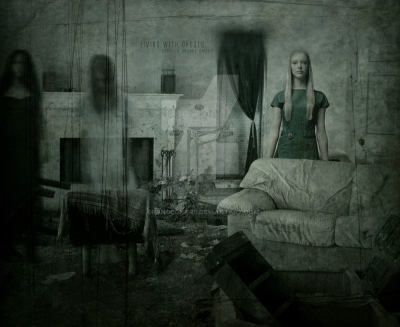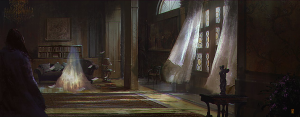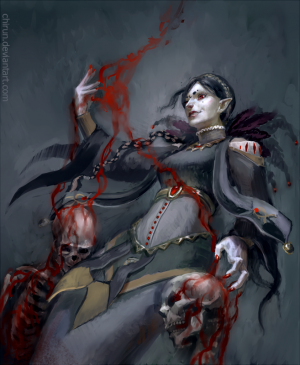"Wraith" is a kinder word to refer to what are commonly known to mortals as ghosts: spirits of the dead who, for one reason or another, cannot move on into whatever afterlife or oblivion awaits them. Wraiths represent only a very small portion of those who die, since most people move on immediately and are not trapped in the strange half-alive state that Wraiths find themselves in after death. They can affect the world of the living somewhat, although not frequently and not reliably, and are generally the most "invisible" of the supernatural beings; even other supernatural creatures may not have the ability (or the interest) to realize that they are there or contact them in any way.
Although they do have mysterious "societies" of their own beyond the veil, Wraiths are for the most part not organized in any meaningful way, and each operates according to their own goals and emotions. Many Wraiths are just trying to move on, find a way to leave their shadow existence and arrive wherever they think they were "supposed" to go; others desperately cling to the land of the living, doing their utmost to still affect it and feel like a part of it in spite of being deceased. A few can no longer stand the torment of their state and become Spectres, terrible vengeful ghosts with no thought except to cause pain and fear in others, and these are the common Hollywood conception of malevolent ghosts targeting the living.
Wraiths in the Mortal World
Evidence of Wraiths in the mortal world is generally scant since they have difficulty affecting anything there, but over time even human beings have become aware (even if only through superstition) of the presence of the dead among them. Wraiths who concentrate and have the appropriate skills can move or knock over objects, cause sounds or images to appear, or even occasionally manifest themselves, and humans seldom fail to notice such terrifying events. Of course, most Wraiths don't care to spend that much energy on just frightening and discombobulating humans, but some do it for entertainment purposes, and others as a desperate way of reaching out to lost loved ones or old enemies.
Some few mortals are sensitive enough to Wraiths to be called mediums, and may be able to contact them in areas where they are especially present. Of course, far more mortals are lying or deluded about this than have genuine talent, but it would be untrue to say that no humans are able to contact Wraiths on occasion. Such connections are usually tenuous and unstable, and the mortal often doesn't get a very clear sense of what the Wraith is doing or wants, which results in considerable frustration for the Wraith.
Spectres - angry, tortured Wraiths who have lost all humanity and exist only to injure and destroy - are responsible for most classical "hauntings" in the mortal world, since they hate the living just as much as everything else and are only too willing to expend their energy on dragging furniture around, shrieking in the night, or making the walls bleed. Normal Wraiths may also sometimes enact hauntings, particularly if they feel threatened or feel that the things important to them in their lives could be protected by doing so. Hauntings by Wraiths are generally more benign, while Spectral hauntings can and do sometimes result in the deaths of any living people unfortunate enough to be caught in the area.
Fetters
Fetters are the ties that bind Wraiths to the mortal world - usually objects that carried great significance for them in life, or that represent an important problem, feeling, or issue that is preventing them from moving on. Fetters can be almost anything, although they are usually personal items: a beloved doll, a treasured heirloom, a piece of clothing worn at a crucial time in a person's life, a symbol of love or betrayal, or a painting of a person during turmoil are all common fetters, which capture both the essence of the Wraith in life and the issue that hold them in their current state. There is no limit on the size or shape of a fetter, except that it has to be very important to its Wraith; in some extreme cases, a Wraith might have an entire house as their fetter, or even a person whom they have extremely strong feelings about.
Fetters are both a blessing and a curse; they keep the Wraith tied to the world and unable to move on, but also keep them anchored enough that they are not dragged off course by the psychic winds of oblivion and eventually destroyed. Ideally, Wraiths seek to resolve their issue through their fetter, learning to accept or let go of whatever emotions bind them to it; when they do, they pass onward, although to where is a matter of debate. If a fetter is destroyed, on the other hand, the Wraith's ties to the mortal world are cut, but they are not sent on to their final destination; most such Wraiths drift in the void until they are destroyed, or are at the very least never heard from again. Both methods work to prevent a Wraith from interfering in the mortal world, although one is obviously kinder than the other.
Wraiths are unable to directly interfere with their own fetters; even with all their powers marshaled, they cannot move, alter, or in any way touch the object of their discontent. Wraiths whose fetters are people can still cause haunting effects around them, but cannot touch or interfere with them; Wraiths with buildings as fetters can move items around and cause effects within that building, but are incapable of doing anything that would severely damage it or change its structure.
Ghostly Powers
Compared to the other supernatural powers of the world, Wraiths are comparatively pretty powerless. Most of their powers have to do with forcing their way past the veil of death to affect things in the living world; they might be centered around moving objects in spite of no longer having a body, being able to speak or make noises that are heard by the living, projecting their emotions to those who enter the area of their fetters, or in extreme cases possessing living things for brief periods of time. The height of Wraith power is generally considered the ability to manifest as if they were a living human, which is very impressive for them but often goes unnoticed by other beings who are not very impressed by seeing just another human on the street.
A few Wraiths have other, more dangerous powers, including raising their own (or any others they can get their spectral hands on) corpses for a brief period of time, causing large-scale and physically dangerous poltergeist-like effects, invading the dreams of the living with their baleful pronouncements, or transforming the very matter of the living world. Such Wraiths are rare and usually do not care to use these powers without a good reason, but any who become Spectres pose a very real and very terrifying threat to life near them.
Of course, Wraiths have other "powers" just by virtue of being ghosts - they cannot be seen or heard unless they wish to be or are confronted with a powerful medium, they cannot be trapped in any way short of powerful magics, and they have no physical body and cannot be hurt unless they choose to manifest concretely. These natural abilities help Wraiths remain in existence for far longer than most other forms of supernatural creatures, rivaling even the eldest of the vampires for longevity, but since they can't do very much to affect their environment, many don't consider it a very good tradeoff.
Wraiths and Vampires
Like mortals, most vampires don't have the ability to perceive Wraiths and are unaware of their existence, dismissing the idea of ghosts as the childish fancy most of the world thinks it is. Vampires often cause Wraiths to come into being if they are careless or violent toward mortals, so once in a while a vampire might be haunted by a vengeful Wraith without ever knowing that it's there (or, if the haunting is severe enough, without really understanding what's happening). Some vampires with high levels of the Auspex Discipline can occasionally catch glimpses of Wraiths out of the corners of their eyes, but they can never see details or be sure that they actually saw anything.
Vampires that practice the art of Necromancy - largely the Giovanni clan, although necromancers are not unknown in other vampire clans and sects - are frequently able to perceive and interact with Wraiths, although whether this is a good thing depends upon which side of the two supernatural races you are. Vampires tend to use Wraiths as unwilling slaves and errand-runners, binding them with rituals and keeping their fetters hostage, and even using some of their more powerful necromantic rites to threaten them with actual destruction; Wraiths obviously do not care for this treatment, but are often helpless to do anything about it. Most slave-Wraiths try to strike back at their masters in small ways, such as taking their commands too literally, failing to tell them important information when not directly asked, or performing small, annoying hauntings that do not truly threaten them.
Wraiths also usually don't recognize vampires on sight, especially if they're doing their best to pass as mortal, although those with special powers pertaining to learning more about the living may discover that something isn't quite right about them. Some powers, such as the Dominate or Obfuscate Disciplines, can be used on Wraiths by vampires, but only if that vampire is already able to perceive and interact with the Wraith, and powers that are purely physical (such as Animalism or Vicissitude) simply fail to do anything.



